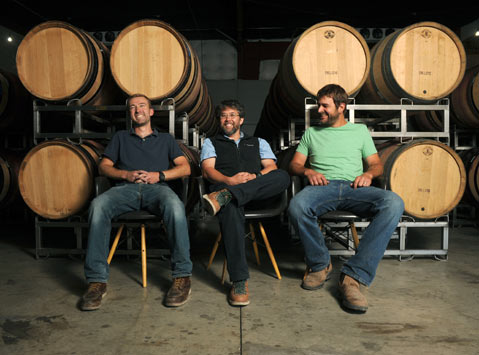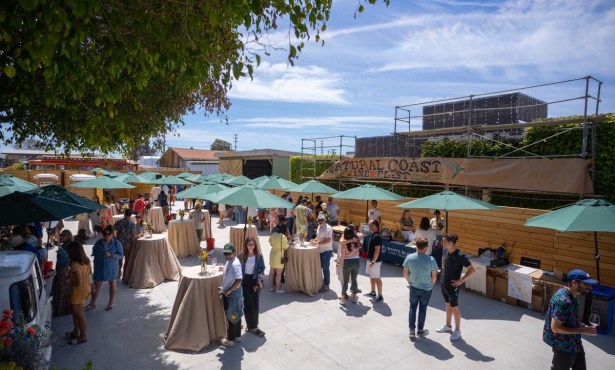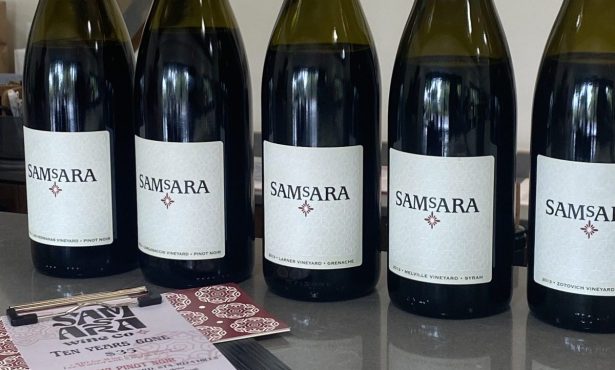Sashi Moorman’s Enology Empire
Changing Santa Barbara Winemaking, One Project at a Time

What else are you working on?”
That’s my favorite question for Santa Barbara winemakers these days since so many of them are involved with multiple labels. That goes for everyone from folks in the family biz, like Chad Melville (who oversees the brand his dad founded, as well as Samsara); to those working for bigger outfits, like Fess Parker Winery’s Blair Fox (who also has an eponymous label) and Dave Potter (who owns Municipal Winemakers); to ultra-premium specialists like Matt Dees of Jonata (also making Goodland Wines, with Potter and others).
This is nothing new to the global wine industry, a musical-chair-like land where it would be somewhat risky to not have fingers in extra pies. But Santa Barbara seems particularly bitten by the second-label bug, perhaps because our wineries tend to be smaller in size, allowing a little more free time than the bigger châteaux of Napa Valley — indeed, even winemakers for some of the biggest, more corporate entities in Santa Barbara don’t seem to have as much secondary work (or at least they don’t publicize it!). And we are a relatively young, emergent region whose rules are still being written, where anything remains possible, even the traditional relationship between employers and employees.
By and large, the benefits are mutual: Winery owners have a happier, more creatively juiced staff making more interesting wines, staff winemakers enjoy flexibility and freedom to spread their wings, and consumers rejoice in a wide variety of offerings, from well-crafted, classical bottlings to fringe projects where experimentation can open new doors. But while all remains mostly groovy, save for a few exceptions over the years, tensions naturally may arise when a hired winemaker’s loyalty is split between more than one master.
That’s where Sashi Moorman swoops in to save the day — well, this man of many wineries created a new business model to save his day at least, and, possibly, chart a path for others to one day follow. Called Provignage, it’s a regionally revolutionary concept that removed Moorman from the employ of any one entity, thereby allowing him to contract with multiple clients without having to ask permission, maintain an intimate focus on the projects he selects, and do so without stepping on too many toes. It’s a structure that’s quite common on the grape-growing side of things — Jeff Newton’s Coastal Vineyard Care, for instance, handles countless accounts — but has yet to break through to winemaking, at least in Santa Barbara.
“It is a problem for people who are employed by a winery and want to do other projects,” said Moorman
“It is a problem for people who are employed by a winery and want to do other projects,” said Moorman, who started Provignage in 2010 after nearly a decade of staff winemaking for Stolpman Vineyards, where he made his name and continues to craft highly respected Rhône-style wines. “It can cause a lot of friction, which is why you have to change the relationship.”
One of the most celebrated winemakers in Santa Barbara County’s second generation, the half-Japanese/half-American, California-born, Japan- and Alaska-raised, and D.C.-high-schooled Vassar College graduate toiled in New York City and Beltway restaurants before coming to Santa Barbara in 1996 to work with regional pioneer Adam Tolmach of The Ojai Vineyard. Five years later, in 2001, he became head winemaker at Stolpman Vineyards, where he focused on both the vines and the vinification, building a national reputation for himself as an up-and-coming name to watch. Soon enough, other projects began calling his name, both from his own mind — such as his more avant-garde label Piedrasassi, a partnership with his former employer Peter Pasten, of Obelisk restaurant in D.C. — and from outside, such as Sandhi, a pinot noir and chardonnay project for renowned sommelier Rajat Parr and financial-titan-turned-vintner Charles Banks, former owner of Screaming Eagle in Napa and Jonata, next door to Stolpman.
Today, Moorman, who is 41 years old, and his wife/trusted adviser, Melissa Sorongon, are the captains of a Provignage team that includes assistant winemakers John Faulkner, formerly of Fiddlehead and Santa Barbara Winery, and the recently hired South African Lucinda Heyns, who are both under 30 years old. Also in the mix is vineyard expert and longtime colleague Chris King, whose Cosecha Farming helps bridge the gap between vine and wine. Together, they handle a slowly increasing number of projects, some publicly known (like the Parr-related Domaine de la Côte, which took over the former Evening Land Vineyard in the far western Sta. Rita Hills) and others not yet so. But Moorman makes it very clear that they are the actual winemakers, not merely consultants who get paid big bucks to come in, drop some knowledge on staff winemakers, get their name associated with a bottle, and then hit the road. “I’ve done the consulting thing, but I’m not a fan of it,” said Moorman, admitting that it would be an easier way to make a lot of money. “That’s not what I’m interested in at all. I love making wine.”
Moorman hopes to bring employees on as co-owners down the road and run Provignage much like a law firm or doctor’s office, where partners are responsible for attracting and maintaining projects. “I’d like for them to at least believe that this could be the last winemaking job they ever have,” said Moorman, “that there is opportunity to learn and grow and make enough money and achieve success at one company.” There is one hook, though: While Moorman would not oppose them working on projects outside of Provignage, they’d have to leave the company to do so.
Luckily for the team — and a large part of what makes Provignage work at all — they are based in the ever-exciting Lompoc Wine Ghetto, and so are all of their clients. “It really is a workshop,” said Moorman, describing how the nearly 20 wineries there share equipment and resources and “cross-pollinate” their creativity and wisdom. “That’s why the Wine Ghetto is so important to me. Without this place, I wouldn’t be able to do what I’m doing now.” Perhaps more critically, if his clients were scattered around the region, with long drives between them, Moorman simply wouldn’t have the time in his day to remain hands-on with all of them.
The other critical component is that Moorman only works with clients who have the vision, courage, and resources to try new things. “If you take the conservative route, you will never make anything special,” said Moorman, who admires people like Tom and Peter Stolpman, who took a risk on hiring Moorman more than a decade ago and are still reaping the rewards. “They have great capacity for risk, and they truly love the wine business.”
More significantly, the Stolpmans and Moorman’s other clients appear to appreciate what Provignage is all about. “We’re some of the hardest-working winemakers in the county,” said Moorman. “As long as our clients continue wanting to push ahead, that’s what we offer.”
Samples of Sashi Moorman
Piedrasassi Wine/New Vineland Bread: 1501 East Chestnut Avenue, Lompoc Wine Ghetto; 736-6784; newvineland.com.
Stolpman Vineyards: 1700 Industrial Way, Unit B, Lompoc Wine Ghetto, and 2434 Alamo Pintado Avenue, Los Olivos; 688-0400; stolpmanvineyards.com.
Sandhi Wines: “The Watering Hole,” 2329 Jonata Avenue, Los Olivos; 688-1341; sandhiwines.com.
Domaine de la Côte: 1503 East Chestnut Avenue, Lompoc; 736-6784; domainedelacote.com.



